The Development And Historical Context Of Martial Arts Worldwide
The Development And Historical Context Of Martial Arts Worldwide
Blog Article
Material Author-Winkler Vick
Martial arts have a remarkable background that spans centuries and continents. You might locate it intriguing how ancient practices like Shuai Jiao and Kalaripayattu laid the groundwork for modern-day battle methods. These disciplines not just highlight physical skills but additionally show the societies that birthed them. As you explore their evolution, consider how globalization has changed these traditional types right into crossbreed styles. What influences do you think have shaped today's martial arts landscape?
Ancient Martial arts: The Structures of Battle
As you explore the world of old martial arts, you'll find the rich foundations that shaped combat techniques throughout societies. what is best martial art for street fighting focused on Self-Defense and survival, typically integrating strikes, hurting, and weapons.
In old China, as an example, methods like Shuai Jiao stressed tosses and joint locks, while India's Kalaripayattu showcased dexterity and fluid activity. Japanese samurai developed Kenjutsu, a polished swordsmanship that highlighted self-control and strategy.
These martial arts served not just for fight but likewise as a way of personal advancement, instilling values like regard and perseverance. how old do kids need to be for martial arts blending of these techniques with time laid the groundwork for the diverse martial arts you see today, each showing the one-of-a-kind approaches and requirements of its culture.
The Cultural Impact on Martial Arts Growth
While martial arts typically reflect the functional requirements of a culture, they additionally embody the cultural values and ideas of their beginnings. When you discover different martial arts, you'll discover exactly how they're affected by faith, ideology, and social standards.
For instance, the emphasis on respect and discipline in Japanese martial arts originates from Zen Buddhism and samurai society. In contrast, Brazilian Jiu-Jitsu promotes adaptability and technique, shaped by the need for performance in a varied, multicultural setting.
You might locate that the rituals, attires, and training methods show an area's background and identity. By understanding these cultural impacts, you strengthen your gratitude of martial arts and their role in shaping human experiences around the world.
Modern Adaptations and the Globalization of Martial arts
Martial arts have changed considerably in current years, adapting to contemporary culture and global impacts. You'll discover that typical kinds have combined with modern methods, producing hybrid styles like mixed martial arts. These adaptations satisfy varied audiences, making martial arts available and appealing worldwide.
With the increase of social media and digital platforms, you can find tutorials and competitions from all corners of the globe, damaging geographical obstacles. This globalization has brought about a shared appreciation for numerous techniques, from Brazilian Jiu-Jitsu to Taekwondo.
As you engage with these arts, you'll understand they're not just about battle; they promote physical fitness, technique, and psychological wellness.
Eventually, modern-day adjustments have enhanced the martial arts landscape, making it a vibrant and developing technique.
Verdict
In exploring the history and evolution of martial arts, you reveal a fascinating blend of techniques, societies, and viewpoints. From old self-controls like Shuai Jiao and Kalaripayattu to the modern flexibility seen in mixed martial arts, martial arts show mankind's quest for Self-Defense and individual growth. As you engage with these methods, you not only obtain abilities however additionally a deeper appreciation for the varied practices that form our world today. So, continue your journey and embrace the art of combat!
